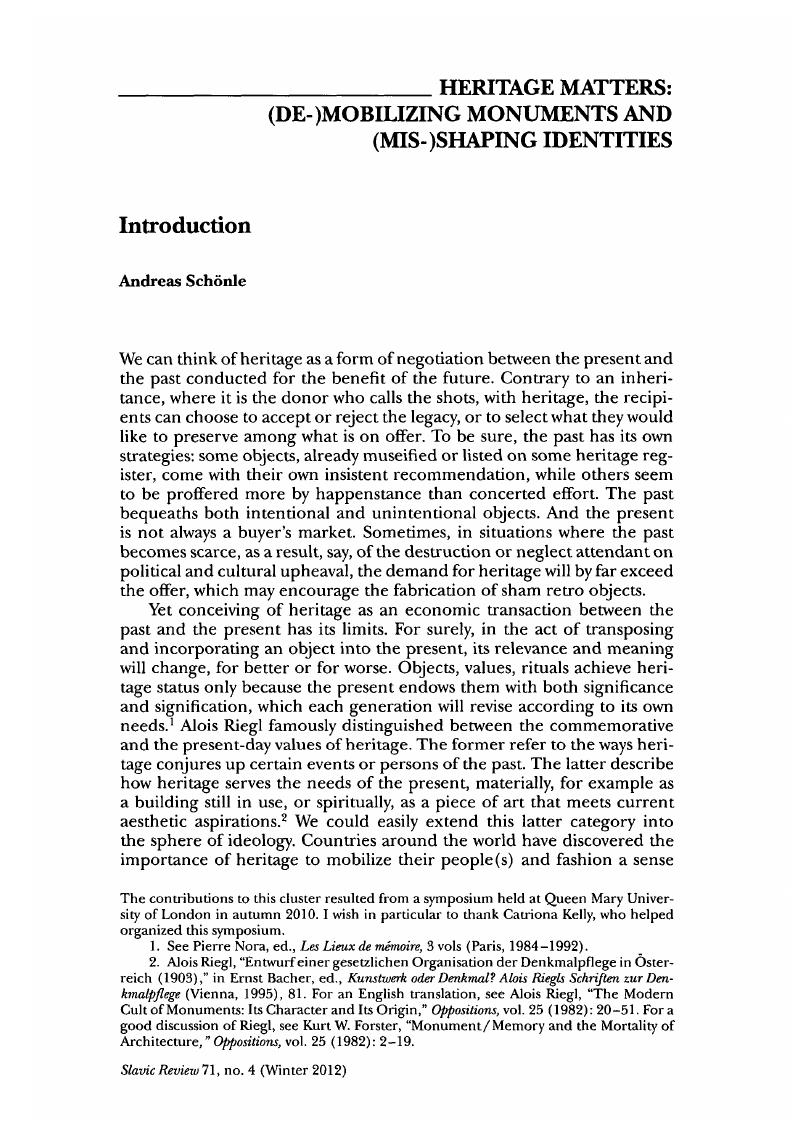Article contents
Abstract

- Type
- Heritage Matters: (De-)Mobilizing Monuments and (MIS-)Shaping Identities
- Information
- Copyright
- Copyright © Association for Slavic, East European, and Eurasian Studies. 2012
References
The contributions to this cluster resulted from a symposium held at Queen Mary University of London in autumn 2010. I wish in particular to thank Catriona Kelly, who helped organized this symposium.
1. See Nora, Pierre, ed., LesLieux de mémoire, 3 vols (Paris, 1984-1992).Google Scholar
2. Riegl, Alois, “Entwurf einer gesetzlichen Organisation der Denkmalpflege in Österreich (1903),” in Bacher, Ernst, ed., Kunstwerk oder Denkmal? Alois Riegls Schriften zur Denkmalpflege (Vienna, 1995), 81.Google Scholar For an English translation, see Riegl, Alois, “The Modern Cult of Monuments: Its Character and Its Origin,” Oppositions, vol 25 (1982): 20–51.Google Scholar For a good discussion of Riegl, see Forster, Kurt W., “Monument/Memory and the Mortality of Architecture,“Oppositions, vol. 25 (1982): 2–19.Google Scholar
3. Herscher, Andrew, Violence Taking Place: The Architecture of the Kosovo Conflict (Stanford, 2010).Google Scholar
4. On various understandings of the notion of culture, see Williams, Raymond, Culture ([London], 1981), 9–14.Google ScholarPubMed For an influential anthropological definition of culture, see Geertz, Clifford, The Interpretation of Cultures (New York, 1973), 3–30.Google Scholar
5. Hall, Stuart, “Whose Heritage? Un-Settling ‘The Heritage,’ Re-Imagining the Post-Nation,” in Fairclough, Graham J., Harrison, Rodney, Jameson, John H. Jr., and Schofield, John, eds., Heritage Reader (London, 2008), 219.Google Scholar Emphasis added.
6. See Byrne, Denis, “Heritage as Social Action,” in Fairclough, , Harrison, , Jameson, , and Schofield, , eds., Heritage Reader, 151.Google Scholar
7. Lowenthal, David, The Heritage Crusade and the Spoils of History (Cambridge, Eng., 1998), 89.CrossRefGoogle Scholar
8. Ibid., 104.
9. Ibid., 128-29.
10. Davison, Graeme, “Heritage: From Patrimony to Pastiche,” in Fairclough, , Harrison, , Jameson, , and Schofield, , eds., Heritage Reader, 35–36.Google Scholar
11. On the tension between heritage professionals, who presume to determine the value of heritage for future generations, and local communities, see Byrne, “Heritage as Social Action,” 168-69.
12. Cecil, Clementine, Harris, Edmund, Bronovitskaia, Anna, and Khrustaleva, Marina, eds., Moscow Heritage at Crisis Point 2004-2007 (Moscow, 2007)Google Scholar; Bronovitskaia, Anna, Cecil, Clementine, and Harris, Edmund, eds., Moscow Heritage at Crisis Point, vol. 2 (Moscow, 2009)Google Scholar; Stadnikov, Vitalii, Cecil, Clementine, and Gozak, Audrey, eds., Samara: Endangered City on the Volga (Samara, 2009)Google Scholar; Cecil, Clementine and Minchenok, Elena, eds., St. Petersburg: Heritage at Risk (St. Petersburg, 2012)Google Scholar.
13. Moscow Heritage at Crisis Point 2004-2007, 100. Somewhat different figures are to be found in Konstantin Mikhailov, “Uroki moskovskogo pogroma,” Khronika unichtozheniia staroi Moskvy: 1990-2006 (Moscow, 2006), 7.
14. Quoted in Mikhailov, “Uroki moskovskogo pogroma,” 15.
15. For a more detailed analysis, see Schönle, Andreas, Architecture of Oblivion: Ruins and Historical Consciousness in Modern Russia (DeKalb, 2011), 219-30.Google Scholar
16. See the footage “Piar-proval Vladimir Putina” at http://www.utro.ru/articles/2011/08/12/991941.shtml (last accessed 21 September 2012).
17. Lowenthal, Heritage Crusade, 139-41.
18. Kalinin, Il'ia, “Nostal'gicheskaia modernizatsiia: Sovetskoe proshloe kak istoricheskii gorizont,” Neprikosnovennyi zapas, no. 6 (74) (2010): 6–16.Google Scholar
19. Kalinin, Il'ia, “Perestroika pamiati,” Neprikosnovennyi zapas, no. 2 (64) (2009): 259-65.Google Scholar
20. A proper history of this chapter of Soviet history is yet to be written. See Yitzhak M. Brudny, Reinventing Russia: Russian Nationalism and the Soviet State, 1953-1991 (Cambridge Mass., 1998), 138-42; Katriona Kelli [Catriona Kelly], ‘“Ispravliat” li istoriiu? Spory ob okhrane pamiatnikov v Leningrade 1960-1970-kh godov,” Neprikosnovennyi zapas, no. 2 (64) (2009), at http://www.magazines.russ.ru/nz/2009/2/kk7-pr.html (last accessed 21 September 2012); Pamiatniki arkhitektury v sovetskom soiuze: Ocherki istorii arkhitekturnoi restavratsii, ed. A. S. Shchenkov (Moscow, 2004), 590; Cohen, Jean-Louis, “Soviet Legal Documents on the Preservation of Monuments,” Future Anterior 5, no. 1 (2008): 62–63.Google Scholar
21. See Arkhnadzor's “Manifesto“(25 February 2009), at http://www.archnadzor.ru/manifest/ (last accessed 21 September 2012). In an interview posted on Arkhnadzor's Web site, Rustam Rakhmatullin frames the activities of the association purely in terms of a metanarrative of progress that is identified with increasing degrees of self-control: “Self-limitation,” he states, “this is progress, whether it be in a historical city, or in the soul of people.” “Sut’ voprosa” (29 October 2009), at http://www.archnadzor.ru/sut-voprosa/ (last accessed 21 September 2012).
22. See Marietta Chudakova, Nekhoroshaia lestnitsa (Moscow, 2009). Short version at Marietta Chudakova, “Istoriia ‘Nekhoroshei’ lestnitsy,” at http://www.bulgakovmuseum.ru/house-10/stairs (last accessed 21 September 2012). On the Bulgakov graffiti, see Bushnell, John, “A Popular Reading of Bulgakov: Explication des Graffiti,” Slavic Review 47, no. 3 (Fall 1988): 502-11.CrossRefGoogle Scholar
23. The project resulted in a photographic exhibit and an album, Gleb Ershov and Stanislav Savitskii, Progulki za iskusstvom (St. Petersburg, 2008).
24. The Moscow Cultural Walks (Moskultprog) present a related if slightly less irreverent, more historical, and more public cousin to these promenades. For a description, see Benton, Tim and Cecil, Clementine, “Heritage and Public Memory,” in Benton, Tim, ed., Understanding Heritage and Memory (Manchester, Eng., 2010), 33–40.Google Scholar
25. Ershov, Gleb and Savitskii, Stanislav, “Gde Kifer? I gde Bois?” in Ershov, and Savitskii, , Progulki za iskusstvom, 13.Google Scholar
26. Gerasimenko, Pavel, “Progulka po Bateninskomu zhilmassivu,” in Ershov, and Savitskii, , Progulki za iskusstvom, 28.Google Scholar
27. Ershov, Gleb and Savitskii, Stanislav, “Krugom vozmozhno iskusstvo,” in Ershov, and Savitskii, , Progulki za iskusstvom, 84.Google Scholar
28. Ershov and Savitskii, “Gde Kifer? I gde Bois?” 12.
29. See George Orwell, 1984, at http://www.gutenberg.net.au/ebooks01/0100021.txt(last accessed 21 September 2012).
- 2
- Cited by


